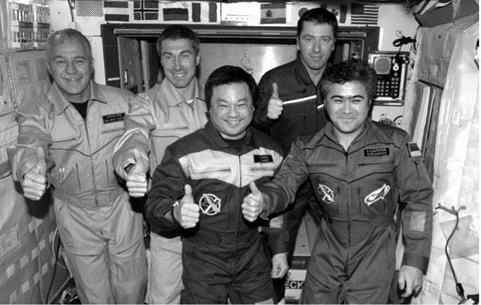. SOYUZ TMA6
Flight Crew
KRIKALEV, Sergei Konstaninovich, 46, civilian, Russian ISS-11 and Soyuz commander, 6th mission
Previous missions: Soyuz TM7 (1988); Soyuz TM12 (1991); STS-60 (1994); STS-88 (1998); ISS-1 (2000/01)
PHILLIPS, John Lynch, 54, civilian, US ISS-11 science officer, 2nd mission Previous mission: STS-100 (2001)
VITTORI, Roberto, 40, Italian Air Force, Soyuz flight engineer, 2nd mission Previous mission: Soyuz TM34 (2002)
Flight Log
The eleventh residency aboard ISS would be the first to receive a Shuttle mission since STS-113 in December 2002. The loss of Columbia and her crew had created the need to fly two-man resident crews, termed caretakers, because orbital operations were restricted by the availability of onboard supplies, and station expansion curtailed by the grounding of the Shuttle. This was the fifth such caretaker crew, but the docking of STS-114 in July signified that full station operations could soon be resumed.
Flying to the station with EO-11 was ESA astronaut Vittori, who completed 23 experiments in 91 sessions under the Eneide programme. His research consisted of studies in human physiology, biology, demonstrations of new technology and a programme of education demonstrations. Vittori would also participate in a number of ceremonial and public relations broadcasts, a feature of most crew exchanges and international missions in space. Vittori would return to Earth aboard TMA5 along with the two ISS-10 crew members.
Almost as soon as the new crew were left alone on the station, their time was taken up by problems with the Elektron system, which finally broke down in early May.
|
Change of shift on ISS. The ISS-10 and 11 crews give the thumbs-up to the continuation of manned station operations. L to r John Phillips and Sergey Krikalev (ISS-11), Leroy Chiao (ISS-10), Italian Roberto Vittori (ESA) and Salizhan Sharipov (ISS-10) |
There were sufficient alternative oxygen supplies aboard the station to keep the crew supplied until the end of the year, with re-supply by the Shuttle and Progress, but it was still disconcerting as troubleshooting on the unit would be added to an already heavy work programme. Other maintenance included work on the treadmill vibration isolation system. The crew received their first re-supply craft (Progress M53) in June, which delivered 2,383 kg of cargo. This included 111 kg of oxygen and 420 kg of water, as well as 40 solid fuel oxygen generation cartridges and spare parts for the Elektron unit.
The crew also completed a range of science studies, including Earth observations, medical experiments, and microgravity research. In addition they tested new software that had been installed to support the Canadarm2 unit on the station and relocated their Soyuz from the Pirs module to the Zarya module on 19 July, freeing the docking compartment for their EVA the following month. The re-docking operation took approximately 30 minutes to complete. During these relocation manoeuvres, the station had to be prepared for autonomous flight, in case the Soyuz failed to re-dock and the crew were forced to return to Earth.
On 28 July, the STS-114 crew docked Discovery with the station, bringing much – welcomed supplies and visitors to the crew, and confidence in the resumption of Shuttle ISS assembly flights. In August, the Russian Vodzukh carbon dioxide removal system failed and while the Russian ground controllers investigated the problem and came up with a repair plan, the American unit in Destiny was activated to take over the operation. On 16 August Krikalev surpassed Sergei Avdeyev’s career record of time logged in space (747 days 14 hours 14 minutes 11 seconds).
The two men performed their only EVA on 17 August (4 hours 57 minutes). For Phillips, it was the first excursion outside a spacecraft in space, but for veteran Krikalev, this was his eighth EVA. Their tasks included retrieving exterior sample cassettes, installing a new reserve TV camera for ATV dockings, and photographing exterior experiments and surfaces. Some of the activities planned for the EVA could not be accomplished due to lack of time and would be rescheduled for later crews. Following their EVA, the crew cleaned their equipment and resumed their scientific and maintenance work in preparation for their next visitors, the crew of Soyuz TMA7 and the third space flight participant. In their final days in orbit, the two men began packing up their research results, increased their exercise programme in preparation for the return to gravity and checked the systems of Soyuz TMA6. They would return to Earth with space flight participant Greg Olsen after he completed his week aboard the station.
During the descent of TMA6, there was a small pressure leak from the DM, which was noted before the undocking from ISS. An obstruction of some kind seemed to have prevented the air tight seal of the forward DM hatch into the OM. On module separation the leak continued to vent, although the crew were protected in their Sokol suits. The landing occurred successfully but Phillips had to be given smelling salts to prevent him drifting into unconsciousness. The astronaut later explained that he was far more uncomfortable in the DM than he had been in the Shuttle he had returned on in 2001. He was not sure if he became unconscious for a short time, but he knew his head was spinning. In images from the recovery operation, he certainly looked weak and pale.
Milestones
243rd manned space flight
99th Russian manned space flight
92nd manned Soyuz mission
6th manned Soyuz TMA mission
39th Russian and 93rd flight with EVA operations
10th ISS Soyuz mission (9S)
8th visiting mission (VC-7)
5th resident caretaker ISS crew (2 person)
Phillips is launched on his 54th birthday (15 Apr)
Krikalev celebrates his 47th birthday in space (27 Aug)
Krikalev sets a new cumulative record of 803 days 9hrs 39 mins in space, on six missions
1st cosmonaut to fly six missions (Krikalev)
1st person to conduct a second residence aboard ISS (Krikalev)











